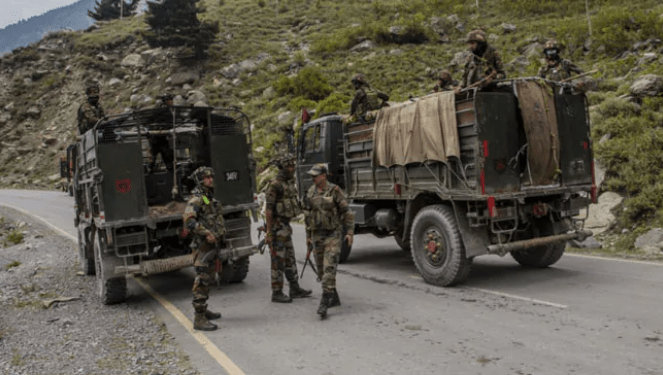Indian Finance Minister Sitharaman released the budget for the fiscal year 2021-2022 on February 1. Among them, the military expenditure part has attracted much attention due to the Sino-Indian border conflict.
As early as the budget was brewing stage, many mainstream media and scholars in India called on the government to increase the military budget, accelerate the speed of national military modernization, and be ready for a long-term confrontation with China in the future.
However, according to The Times of India, the total expenditure of the military expenditure plan (including defense pension) in the new fiscal year is about 4.78 trillion rupees, a slight increase of about 1.4% from the previous fiscal year’s 4.71 trillion rupees.
However, the cost of military spending to strengthen military modernization will reach about 1.35 trillion rupees in the new fiscal year, an increase of nearly 19% over the previous fiscal year.
Indian Defense Minister Singh said on the 1st that “this is the highest increase in the past 15 years”. In contrast, the defense pension fell from 1.33 trillion rupees in the previous fiscal year to 1.15 trillion rupees, a decrease of more than 13%.
“There is no Big Bang growth,” the Times of India said. In India’s military budget, defense pensions for salaries, welfare guarantees and other expenses of active and retired officers and soldiers accounted for a large proportion. “More money for weapons, less pensions, the 2021 defense budget is a step in the right direction,” Swarajya News.
The Hindustan Times reported that if the pension part is removed, the military budget for the new fiscal year is about Rs 3.62 trillion, up 7.3% from Rs 3.37 crore in the previous fiscal year, 1.62% of India’s GDP and 10.4% of total government expenditure.
Bloomberg said on the 2nd that the Indian government’s military budget growth was lower than expected, which questioned its military modernization plan.
Behra, an associate professor at Nehru University, said that India’s defense budget was expected to be “strong growth” due to the conflict between the Chinese and Indian armies last year, but “it seems that the defense minister will have to accompany the deficit in the next few years”.
Indian experts analyzed that “the defense budget reflects the financial constraints faced by the government and the fact that it has to invest in health care and infrastructure to promote economic growth”.
Some people in India pointed out that the defense budget increased by only about 1% in the new fiscal year, and if the inflation rate is taken into account, the defense budget has barely increased. But in fact, this is not the case. In Sitharaman’s speech, another focus is worth paying attention to. The fiscal year’s extrabudgetary arms purchase expenditure.
According to the Hindustan Times, since the Sino-Indian border confrontation, India has spent about 2077.6 billion rupees on emergency purchase of weapons and equipment, including surface-to-air missiles, rocket launchers, air defense systems, GPS missile-based drugs, tank ammunition, etc.
The United States, Russia, France and Israel are the main countries for India to extract armaments. India Today said that when asked about the stagnant defense budget, Sitharaman chose to look at the positive side. She mentioned how the armed forces have been granted financial power to quickly purchase defense supplies in the past three years.
In addition, according to the Hindu newspaper, the Indian government will set up a “Special Fund for the modernization of defense and internal security”, which can be used to make up for the difference between budget needs and actual allocations in the field of defense and security.
The total size of this fund is about 2.38 trillion rupees in 2021-2026, with a maximum annual use of 5100 billion rupees, and does not account for the regular budget allocation.
Although the coronavirus epidemic has hit India’s economy hard, the Indian media are still encouraging the government to significantly increase military spending.
The Times of India quoted military experts on the 2nd as saying that if India wants to exert “necessary military deterrence” to China and Pakistan, military spending should account for at least 2.5% of GDP.
Although India is the third country in the world after the United States and China in terms of military expenditure scale, the military expenditure of the United States is more than 10 times that of India, and China is nearly four times that of India. Moreover, the cost of “raising the army” in India’s military expenditure is too large, which directly hinders the process of military modernization.
The report also mentioned that the partial decline in China’s defense pension in military spending in the new fiscal year may indicate that the government will raise the retirement age of Indian officers and soldiers. For example, the retirement age of officers at the colonel level may be raised from the current 54 to 57.
Abhijit Singh, a senior researcher at the Indian think tank Observer Foundation, believes that the increase in the military budget in the new fiscal year is “insignificant” and “it is difficult to say whether it can meet the needs of the military for the two fronts of China and Pakistan”.
He said that the budget will at least disappoint the Indian navy, “because the plan to build a new aircraft carrier will be difficult to achieve this year.” He suggested that in the absence of a significant increase in military spending, the Indian military may need to consider other ways to raise funds, such as the integration of the navy, army and air force.



